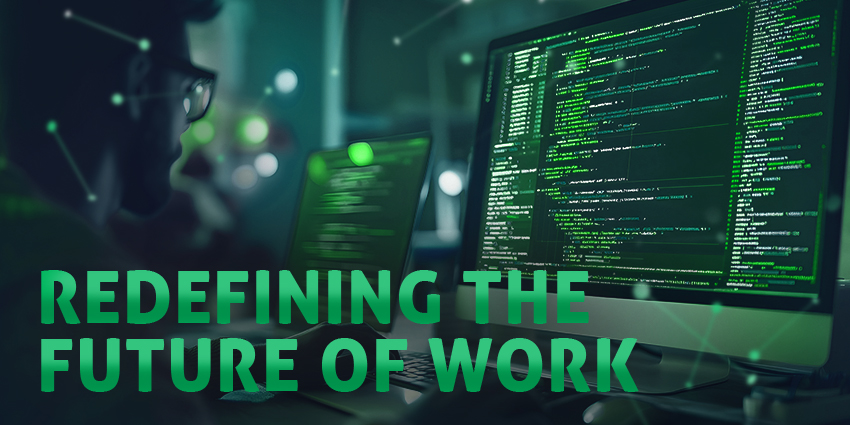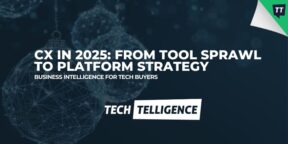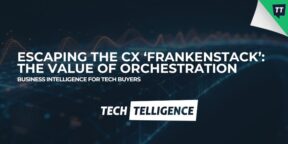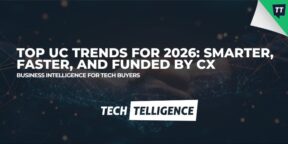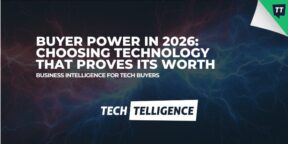The days of “traditional” workplaces are long gone. Welcome to the future, where AI plans and runs your meetings, desks are optional, and monotonous, repetitive tasks are a thing of the past. If 2020 was the year of survival, then 2025 is the year of strategic reinvention.
The workplace is transforming fast – fueled by AI, growing demand for flexibility, and the inherent desire to accomplish more with less. Everyone is feeling the effects of the change, from everyday employees collaborating in the metaverse, to business leaders leveraging predictive AI to improve decision-making and performance outcomes.
So, what’s really shaping the next wave of workplace innovation? Based on our peer-to-peer market research, here’s your guide to the workplace transformation trends worth watching.
AI and Automation: Innovating with Intelligence
AI is everywhere – organizing meetings, handling customer service tasks, and automating more repetitive processes than ever before. According to McKinsey, virtually every company is investing in some form of AI, from Copilots and assistants to agentic AI platforms.
They’re not just using these tools to automate workflows or replace human team members. Companies are leveraging AI to address genuine challenges and explore new opportunities. For instance, retail giants like Sephora are using AI to customize experiences throughout the customer journey. Organizations like the NHS are turning to AI to support overworked medical staff.
On a broader scale, business leaders in every industry are turning to AI to transform decision making. They’re using predictive models to mine insights from huge data sets, and relying on assistants to guide them towards sustainable growth opportunities.
Continued Tech Stack Consolidation
Consolidation has been one of the most significant workplace transformation trends for a while now. Companies are increasingly replacing complex toolsets and systems with all-in-one platforms, such as combined UCaaS, CCaaS, and CPaaS solutions.
This focus on consolidation isn’t just about cutting costs or giving employees fewer disconnected apps to navigate. It’s helping companies align critical data, paving the way for hyper-personalization in the CX space, and agile decision-making in the C-Suite.
Lean technology stacks are ensuring businesses can adapt faster to market changes, and quickly embrace new technologies. In the past, bridging the gaps between various tools would have been a lot more complicated, but low-code and no-code platforms are simplifying things.
Tech leaders like Microsoft, Salesforce, Google, and many others are ensuring their tools can play nicely with other platforms, some even partner with system integration experts, to help businesses build their own connected tech stacks, without hiring full-time developers.
Operational Excellence: Redefining Workflows
Productivity isn’t just about working harder or spending more hours in the office anymore – it’s about working smarter, faster, and more efficiently. The “agile” methodology isn’t just reserved for tech developers and software teams anymore – it’s being implemented organization-wide.
Companies are embracing agile and lean models to nurture rapid experimentation and growth, while reducing waste. Paired with innovative technologies, like AI assistants, copilots, and agentic AI, these methodologies are driving new levels of efficiency in every workplace.
Business leaders are discovering new ways to reduce operational overhead, and differentiate through enhanced efficiency and sustainability. For instance, look at Siemens – it’s using digital twins, AI, and IoT in its factories to optimize every aspect of production, minimizing waste, and increasing output.
According to Spiceworks, smart operations can cut costs by up to 25%, while reducing carbon footprints. At the same time, agile workflows, enhanced by the latest technology, help to reduce the risk of staff burnout and improve employee engagement.
Strategic Innovation in Economic and Financial Management
Economic volatility is the new normal, affecting every business and sector. Inflation, interest rates, global conflicts and more are constantly influencing the world we live in. Companies are exploring intelligent ways to stay ahead – like investing in predictive analytics.
Tools like Anaplan and Workday Adaptive Planning allow finance teams to build agile, data-driven models that can flex as the market shifts. Scenario planning tools are quickly becoming a core part of the average technology stack.
CFOs are becoming digital innovators too, focusing not just on cutting costs – but on improving the “return on investment” achieved by every initiative. Modern budget platforms are allowing companies to use AI to forecast ROI in real-time, shaping intelligent investment decisions.
Business leaders are also becoming more proactive about managing budgets, watching metrics carefully and adjusting licenses and investment strategies constantly – rather than just waiting to make changes at the end of the year.
Human Factors and Innovative Work Cultures
Even with AI and automation increasing across the board, companies can’t afford to overlook the importance of company culture, and the overall human experience in the workplace. Though some companies are attempting to encourage employees back into the office, it’s unlikely we’ll see everyone rushing back to full-time cubicle-based work.
The majority of modern employees demand flexibility – whether it’s a hybrid work strategy, a reduced work week, or customizable schedules. Companies are quickly adapting to the change, designing innovative workspaces that support flexibility, and employee wellbeing.
Some companies are even using extended reality to address hybrid work issues, offering employees an opportunity to collaborate in the metaverse, or train with XR headsets. In fact, our recent report found that training was the top XR use case for 36% of companies.
That makes sense at a time when crucial work skills are evolving. As AI tools automate more processes, employees need hands-on, immersive educational experiences that show them how to complete more complex tasks, and work alongside bots.
The Experience Era for Customers and Employees
For a while now, business leaders have been growing increasingly aware of the connection between employee experience, customer experience, and overall business success. It’s not enough to focus just on keeping customers happy anymore – organizations need to take a holistic approach to improving experiences for everyone – including staff.
That starts with personalization. Already, most companies use artificial intelligence to personalize customer interactions on a granular level. Generative AI bots are excellent at creating dynamic content, while conversational AI tools can personalize sales, marketing, and support experiences.
Those same innovative tools are excellent for personalizing employee experiences too. Today, every staff member can access a custom copilot solution designed to help them with complex tasks, answer questions, provide coaching and deliver feedback. Companies can even use AI to design custom training experiences – and deliver them to team members through XR platforms.
The Evolution of Security and Compliance
Finally, one of the most significant workplace transformation trends affecting businesses this year is the shift in security and compliance standards. Threats in the workplace continue to grow, particularly with he rise of AI systems being used by criminals for deepfakes and automated attacks.
Innovative companies are fighting fire with fire – turning to security systems powered by AI and machine learning for proactive threat detection and response. Similarly, AI tools are helping organizations navigate increasingly complex compliance standards.
With global regulations tightening, businesses are turning to compliance automation. Tools now scan codebases and workflows to flag policy violations before legal gets involved. All the while, business leaders are developing task forces and policies specifically focused on addressing new challenges, like AI governance, and multi-cloud management.
Workplace Transformation Trends: The Next Era
In 2025, the workplace isn’t just a “place”, it’s a dynamic ecosystem of people, platforms, and intelligent solutions. Thriving businesses won’t just focus on keeping up with the changes – they’ll architect the workplace of tomorrow themselves.
That means investing in flexible workplaces, innovative company cultures, and cutting-edge technologies that help to support, align, and upskill teams.
If you want to make sure you’re ready for the next wave of workplace transformation, check out our latest reports for behind-the-scenes insights into trends shaping everything from XR and AI initiatives, to contact centers and communication.


